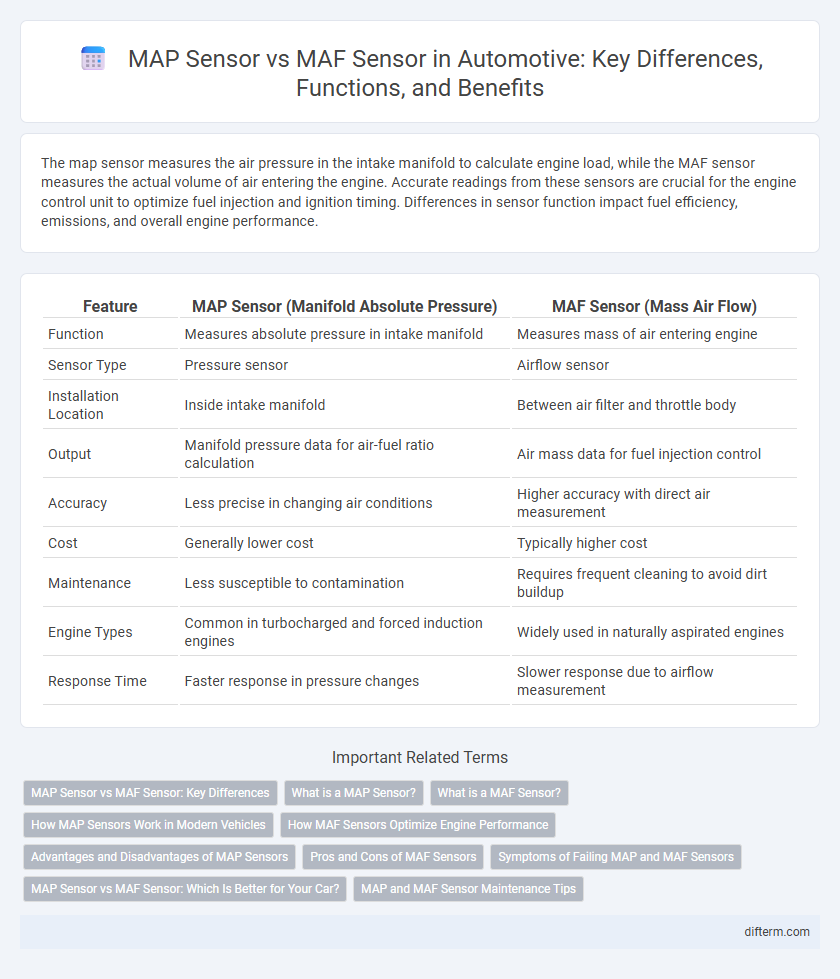The map sensor measures the air pressure in the intake manifold to calculate engine load, while the MAF sensor measures the actual volume of air entering the engine. Accurate readings from these sensors are crucial for the engine control unit to optimize fuel injection and ignition timing. Differences in sensor function impact fuel efficiency, emissions, and overall engine performance.
Table of Comparison
| Feature | MAP Sensor (Manifold Absolute Pressure) | MAF Sensor (Mass Air Flow) |
|---|---|---|
| Function | Measures absolute pressure in intake manifold | Measures mass of air entering engine |
| Sensor Type | Pressure sensor | Airflow sensor |
| Installation Location | Inside intake manifold | Between air filter and throttle body |
| Output | Manifold pressure data for air-fuel ratio calculation | Air mass data for fuel injection control |
| Accuracy | Less precise in changing air conditions | Higher accuracy with direct air measurement |
| Cost | Generally lower cost | Typically higher cost |
| Maintenance | Less susceptible to contamination | Requires frequent cleaning to avoid dirt buildup |
| Engine Types | Common in turbocharged and forced induction engines | Widely used in naturally aspirated engines |
| Response Time | Faster response in pressure changes | Slower response due to airflow measurement |
MAP Sensor vs MAF Sensor: Key Differences
MAP sensors measure absolute manifold pressure to calculate engine load, optimizing fuel injection timing and ignition. MAF sensors measure the volume and density of incoming air, providing precise air flow data for fuel mixture adjustments. Understanding these sensor types helps diagnose engine performance issues and improve fuel efficiency strategies.
What is a MAP Sensor?
A MAP sensor (Manifold Absolute Pressure sensor) measures the pressure inside the intake manifold, providing critical data to the engine control unit (ECU) for optimizing air-fuel mixture and ignition timing. Unlike MAF sensors, which measure the volume of incoming air, MAP sensors detect engine load by monitoring vacuum pressure, improving efficiency in turbocharged and naturally aspirated engines. Accurate MAP sensor readings help enhance fuel economy, reduce emissions, and ensure smooth engine performance.
What is a MAF Sensor?
A MAF sensor, or Mass Air Flow sensor, measures the amount of air entering the engine to optimize fuel injection and combustion efficiency. It provides real-time data to the engine control unit (ECU) for precise air-fuel mixture adjustments, improving performance and emissions. Unlike a map sensor that measures manifold pressure, the MAF sensor directly quantifies airflow for accurate engine management.
How MAP Sensors Work in Modern Vehicles
MAP sensors measure manifold absolute pressure by detecting the vacuum level within the intake manifold, providing real-time data about engine load and air pressure. This information allows the engine control unit (ECU) to calculate the optimal air-fuel mixture for efficient combustion. MAP sensors contribute to improved fuel efficiency, reduced emissions, and enhanced engine performance in modern vehicles.
How MAF Sensors Optimize Engine Performance
MAF sensors measure the precise volume and density of intake air, enabling the engine control unit (ECU) to adjust fuel injection for optimal combustion efficiency. By providing real-time airflow data, MAF sensors help maintain the ideal air-fuel ratio, improving fuel economy and reducing emissions. This optimization ensures smoother engine operation, enhanced throttle response, and better overall performance compared to systems relying solely on map sensors.
Advantages and Disadvantages of MAP Sensors
MAP sensors offer advantages such as simpler design, lower cost, and higher reliability due to fewer moving parts compared to MAF sensors. They provide accurate manifold pressure readings crucial for engine control, especially in forced induction engines, but may struggle with rapid airflow changes affecting transient response. Disadvantages include sensitivity to vacuum leaks and less precise airflow measurement, which can lead to less optimal fuel delivery compared to MAF sensors.
Pros and Cons of MAF Sensors
MAF sensors provide accurate airflow measurements essential for optimal engine performance and fuel efficiency, offering precise real-time data that improves combustion control. However, MAF sensors are sensitive to contamination from dirt and oil, which can lead to incorrect readings and reduced engine performance. Unlike MAP sensors, MAF sensors typically have higher costs and can be more complex to maintain due to their delicate components.
Symptoms of Failing MAP and MAF Sensors
Failing MAP sensors often cause symptoms such as rough idling, poor fuel economy, and engine stalling due to inaccurate manifold pressure readings that affect air-fuel mixture. On the other hand, faulty MAF sensors typically result in hesitation during acceleration, increased emissions, and check engine light activation as incorrect airflow data disrupts fuel delivery. Both sensor issues compromise engine performance, leading to drivability problems and potential damage if not addressed promptly.
MAP Sensor vs MAF Sensor: Which Is Better for Your Car?
A MAP sensor measures the intake manifold pressure to calculate air density and optimize fuel delivery, while a MAF sensor directly measures the volume of air entering the engine for precise air-fuel mixture. MAP sensors perform better in forced induction engines and provide more reliable data in varying altitudes, whereas MAF sensors excel in naturally aspirated engines by offering higher accuracy in airflow measurement. Choosing between MAP and MAF sensors depends on the engine type, driving conditions, and desired fuel efficiency.
MAP and MAF Sensor Maintenance Tips
MAP sensors require regular inspection for vacuum leaks and electrical connections to ensure accurate air pressure readings critical for optimal engine performance. MAF sensors benefit from periodic cleaning with specialized sensor-safe spray to remove accumulated dirt and oil, preventing airflow measurement errors that can affect fuel efficiency. Proper maintenance of both MAP and MAF sensors enhances engine responsiveness, reduces emissions, and prolongs sensor lifespan in modern automotive systems.
map sensor vs maf sensor Infographic

 difterm.com
difterm.com